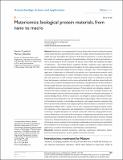Materiomics: biological protein materials, from nano to macro
Author(s)
Cranford, Steven; Buehler, Markus J
DownloadBuehler_Materiomics biological.pdf (2.762Mb)
PUBLISHER_POLICY
Publisher Policy
Article is made available in accordance with the publisher's policy and may be subject to US copyright law. Please refer to the publisher's site for terms of use.
Terms of use
Metadata
Show full item recordAbstract
Materiomics is an emerging field of science that provides a basis for multiscale material system characterization, inspired in part by natural, for example, protein-based materials. Here we outline the scope and explain the motivation of the field of materiomics, as well as demonstrate the benefits of a materiomic approach in the understanding of biological and natural materials as well as in the design of de novo materials. We discuss recent studies that exemplify the impact of materiomics – discovering Nature’s complexity through a materials science approach that merges concepts of material and structure throughout all scales and incorporates feedback loops that facilitate sensing and resulting structural changes at multiple scales. The development and application of materiomics is illustrated for the specific case of protein-based materials, which constitute the building blocks of a variety of biological systems such as tendon, bone, skin, spider silk, cells, and tissue, as well as natural composite material systems (a combination of protein-based and inorganic constituents) such as nacre and mollusk shells, and other natural multiscale systems such as cellulose-based plant and wood materials. An important trait of these materials is that they display distinctive hierarchical structures across multiple scales, where molecular details are exhibited in macroscale mechanical responses. Protein materials are intriguing examples of materials that balance multiple tasks, representing some of the most sustainable material solutions that integrate structure and function despite severe limitations in the quality and quantity of material building blocks. However, up until now, our attempts to analyze and replicate Nature’s materials have been hindered by our lack of fundamental understanding of these materials’ intricate hierarchical structures, scale-bridging mechanisms, and complex material components that bestow protein-based materials their unique properties. Recent advances in analytical tools and experimental methods allow a holistic view of such a hierarchical biological material system. The integration of these approaches and amalgamation of material properties at all scale levels to develop a complete description of a material system falls within the emerging field of materiomics. Materiomics is the result of the convergence of engineering and materials science with experimental and computational biology in the context of natural and synthetic materials. Through materiomics, fundamental advances in our understanding of structure–property–process relations of biological systems contribute to the mechanistic understanding of certain diseases and facilitate the development of novel biological, biologically inspired, and completely synthetic materials for applications in medicine (biomaterials), nanotechnology, and engineering.
Date issued
2010-11Department
Massachusetts Institute of Technology. Department of Civil and Environmental Engineering; Massachusetts Institute of Technology. Department of Materials Science and Engineering; Massachusetts Institute of Technology. Laboratory for Atomistic and Molecular MechanicsJournal
Nanotechnology, Science and Applications
Publisher
Dove Medical Press
Citation
Buehler, Markus J., and Cranford. “Materiomics: Biological Protein Materials, from Nano to Macro.” Nanotechnology, Science and Applications (2010): 127.
Version: Final published version
ISSN
1177-8903